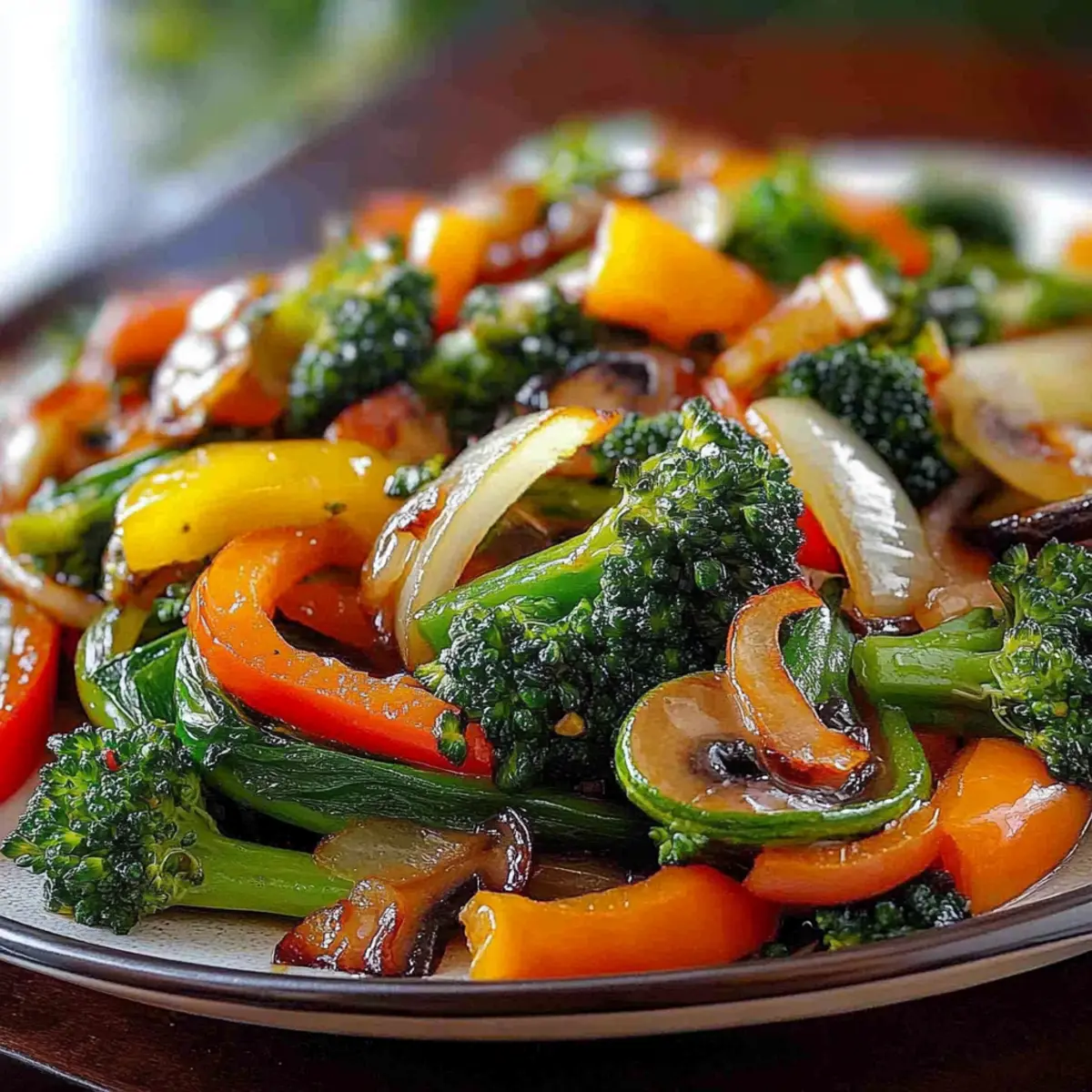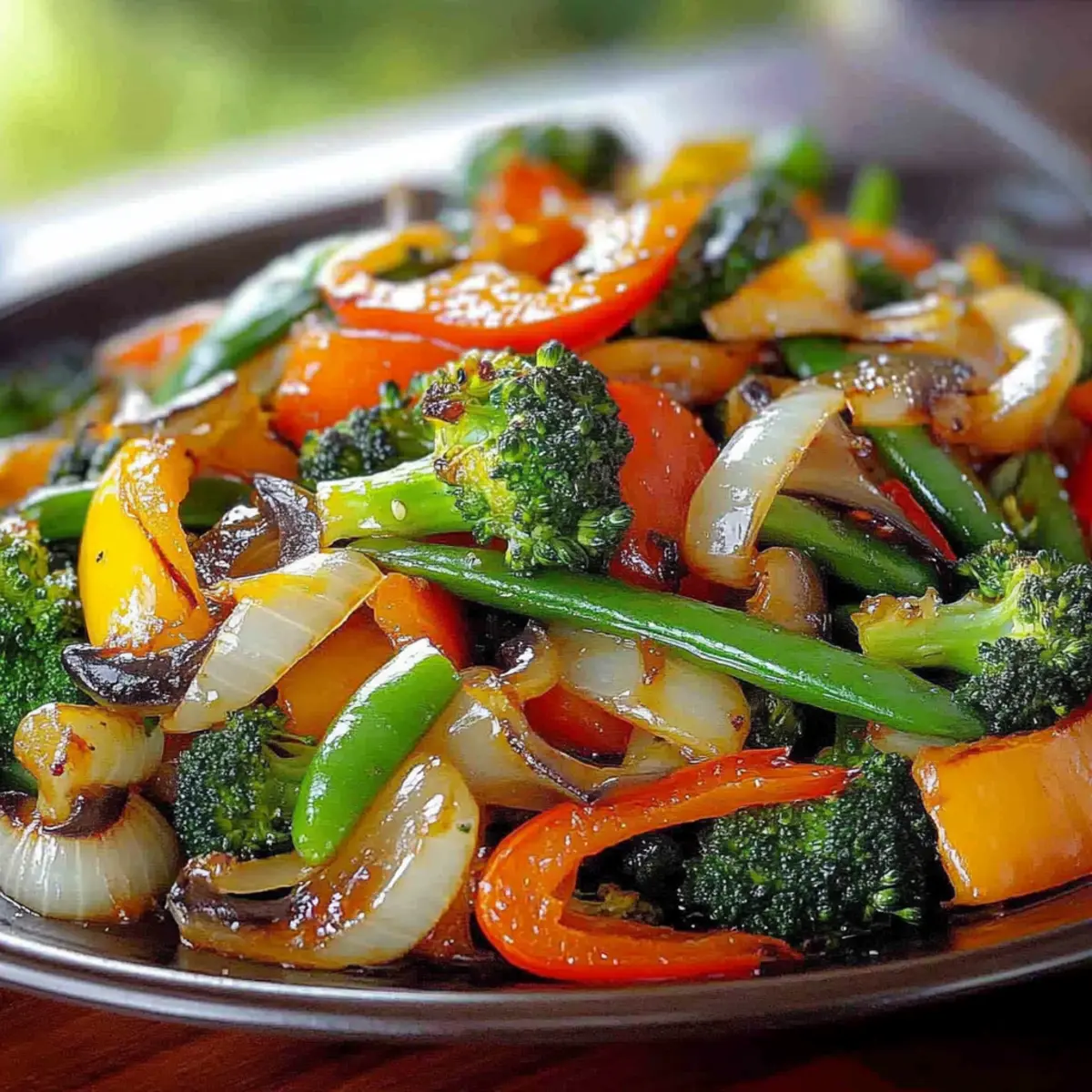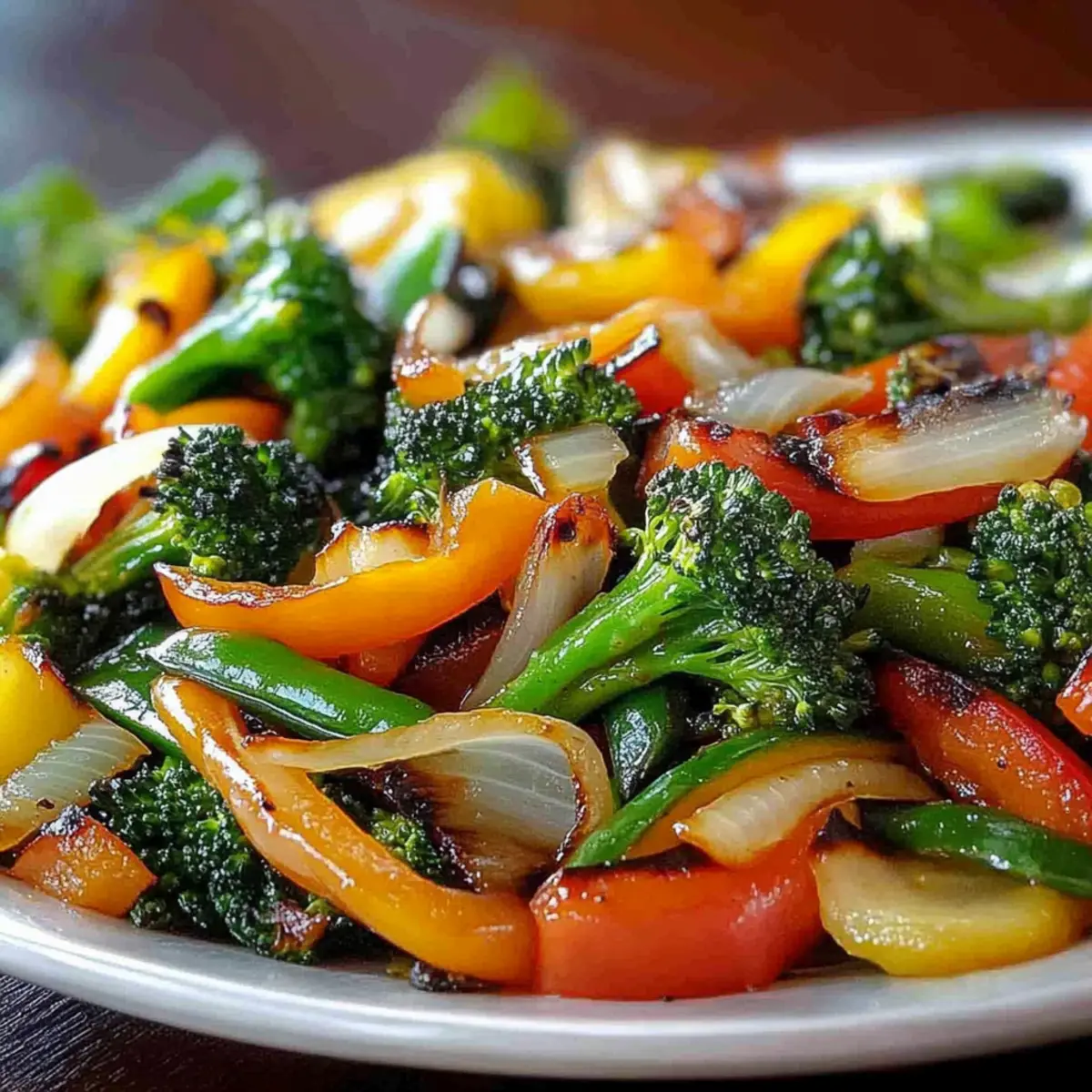Picture this: the aroma of sizzling garlic and fresh vegetables wafts through your kitchen, igniting your senses and filling your home with warmth. That’s the magic of Healthy Sautéed Vegetables; they effortlessly transform any meal into a vibrant feast. This recipe is not only quick to prepare—perfect for busy weeknights—but also bursting with essential nutrients that make it a guilt-free indulgence. Whether you’re a passionate home chef or someone looking to elevate your dining experience, these sautéed vegetables can cater to both your healthy lifestyle and your taste buds. With multiple flavoring options, from Mediterranean to spicy Asian-inspired variations, you’re bound to discover a combination that dazzles. Are you ready to toss those take-out menus aside and embrace the colorful crunch of homemade sautéed goodness? Let’s dive in!

Why Choose Healthy Sautéed Vegetables?
Quick cooking: This recipe delivers a nutritious side dish in under 20 minutes, making it perfect for those busy weeknights.
Endless flavor options: Whether you crave Mediterranean zest, Asian-inspired depth, or a spicy kick, there’s a variation for everyone!
Healthy benefits: Packed with fiber, vitamins, and antioxidants, these vegetables support a balanced diet without sacrificing taste. Pair them with some healthy sautéed vegetables and enjoy the vibrant flavors added to any main dish.
Crowd pleaser: With a colorful presentation and delightful textures, they’re sure to impress family and friends at your next gathering.
Meal prep friendly: Chop your vegetables ahead of time and quickly sauté them for an easy week-long addition to lunches or dinners!
Healthy Sautéed Vegetables Ingredients
• Here’s everything you need to make delicious Healthy Sautéed Vegetables that will brighten up your meals!
For the Sauté
- Olive Oil – A heart-healthy cooking fat that enhances flavors; consider avocado oil for a nutty twist.
- Garlic – Minced for aromatic flavor that infuses beautifully into the veggies.
- Onion – Sweet and savory base that caramelizes; shallots are a mild alternative.
For the Vegetables
- Bell Pepper – Adds sweetness and vibrant color; feel free to swap in any colorful variety.
- Zucchini – Provides moisture and tenderness; summer squash is a great substitute.
- Broccoli Florets – Firm and nutritious; if unavailable, green beans work well too.
- Carrot – Offers sweetness and a pop of color; julienned for faster cooking; parsnips can be used as an alternative.
- Snap Peas – A sweet, crisp addition; edamame can be an interesting substitute.
- Mushrooms – Contributes umami flavor; can be omitted or replaced with eggplant if preferred.
Seasoning & Extras
- Salt and Pepper – Essential seasonings to enhance all flavors; adjust to your liking.
- Lemon Juice/Balsamic Vinegar/Soy Sauce (optional) – These add a burst of flavor; lime juice can substitute for lemon if desired.
Optional Toppings
- Toasted Nuts – Add delightful crunch and flavor; almonds or walnuts are fantastic choices.
- Fresh Herbs – Brightens up the dish; parsley or basil are both excellent options.
- Parmesan Cheese – For a savory finish, sprinkle a little cheese on top if you’re not strictly vegan.
Step‑by‑Step Instructions for Healthy Sautéed Vegetables
Step 1: Prep Vegetables
Start by washing all your vegetables thoroughly under cold water. Peel any necessary veggies, such as carrots, and then cut them into uniform pieces to ensure even cooking. Aim for bite-sized chunks that will cook through quickly, enhancing the colorful appeal of your Healthy Sautéed Vegetables.
Step 2: Heat Pan
In a large skillet, preheat over medium-high heat for about 2 minutes. Add 2 tablespoons of olive oil to the hot skillet, swishing it around to coat the bottom. You’ll know it’s ready when the oil shimmers and begins to ripple slightly. This will create the perfect foundation for sautéing your vegetables.
Step 3: Cook Aromatics
Next, add 2-3 cloves of minced garlic and 1 sliced onion to the sizzling oil. Sauté for 1-2 minutes, stirring frequently until the onion becomes translucent and the garlic is fragrant. This aromatic base adds depth to your Healthy Sautéed Vegetables, ensuring every bite is packed with flavor.
Step 4: Add Harder Vegetables
Introduce the firmer vegetables first: 1 julienned carrot and 1 cup of broccoli florets. Cook these for about 3-4 minutes, stirring often until they start to soften while still retaining a bit of crunch. This technique allows the flavors to meld and prepares your veggies for the next round of cooking.
Step 5: Add Softer Vegetables
Now, it’s time to add the colorful softer vegetables: 1 sliced bell pepper, 1 sliced zucchini, 1 cup of mushrooms, and a handful of snap peas. Sauté everything together for an additional 4-5 minutes, stirring occasionally until the vegetables are crisp-tender and vibrant. This stage brings the dish to life with a beautiful array of colors.
Step 6: Season & Finish
Lastly, season your Healthy Sautéed Vegetables with salt, pepper, and a splash of lemon juice, balsamic vinegar, or soy sauce, depending on your flavor preference. Toss well to ensure all the veggies are coated, then remove them from the heat. This final touch enhances the natural sweetness of the vegetables while adding a zesty kick.

Healthy Sautéed Vegetables Variations
Embrace the flexibility of this recipe and explore delightful options that will add even more deliciousness to your Healthy Sautéed Vegetables!
-
Mediterranean Boost: Mix in crumbled feta cheese and fresh oregano for a zesty, savory flair that transports your taste buds. The herby aroma fills the air, making every bite a little Mediterranean getaway.
-
Asian-Inspired Twist: Drizzle with soy sauce and sesame oil, finishing with a sprinkle of sesame seeds to bring an umami flavor explosion. Pair this variation with rice, and you’ll have a quick and satisfying meal!
-
Spicy Kick: Ignite your palate by tossing in chili flakes or a dollop of sriracha for a fiery finish. The heat beautifully complements the natural sweetness of the vegetables, resulting in a tantalizing blend that excites the senses.
-
Herb-Forward Flavor: Infuse freshness by adding a handful of fresh thyme or basil to your sautéed veggies. This herbaceous twist creates a light and aromatic experience, perfectly elevating your vibrant vegetable medley.
-
Citrus Zest: Squeeze in some lime juice instead of lemon for a different tangy brightness that pairs wonderfully with the vegetables. This variation is especially refreshing during warm months!
-
Nutty Texture: Stir in some toasted pine nuts or sliced almonds just before serving for that delightful crunch. It’s a simple addition that enhances both taste and texture, leaving everyone asking for more!
-
Cheesy Creaminess: For a richer flavor, consider adding shredded Parmesan or nutritional yeast for a vegan-friendly cheesy touch. It brings a delicious creaminess that complements the crisp-tender vegetables beautifully.
-
Colorful Medley:Experiment with a variety of seasonal vegetables and herbs, like asparagus or baby corn, to keep things interesting. It’s a wonderful way to enjoy what’s fresh and available, creating an ever-changing dish daily!
Feel free to explore these variations, and don’t forget to keep those meal prep options handy so you can whip up a batch of healthy sautéed vegetables whenever you need a nutritious side!
How to Store and Freeze Healthy Sautéed Vegetables
Fridge: Store leftover sautéed vegetables in an airtight container in the fridge for up to 3-4 days. Reheat in a skillet with a splash of water to restore moisture and warmth.
Freezer: For longer storage, freeze sautéed vegetables in freezer-safe bags or containers for up to 3 months. Lay flat to freeze for easy stacking and reheating.
Thawing: When ready to use, thaw in the refrigerator overnight or sauté directly from Frozen, adding a little extra cooking time to ensure even heating.
Meal Prep Tip: Chop fresh vegetables ahead of time and store them separately to streamline future meal prep featuring these delicious Healthy Sautéed Vegetables.
What to Serve with Healthy Sautéed Vegetables
Picture a delightful dining experience unfolding with sizzling colors and vibrant flavors; the perfect supporting act makes your meals a feast for the senses.
-
Grilled Chicken: The smoky flavor of grilled chicken complements the vibrant sautéed vegetables, creating a balanced and hearty meal.
-
Quinoa Salad: A light and nutty quinoa salad adds texture and contrasting flavors, making every bite satisfying and nutritious. Toss in some fresh herbs for an extra lift!
-
Garlic Bread: Warm, buttery garlic bread brings a comforting warmth, perfect for soaking up any drizzled sauces from your sautéed vegetables.
-
Lentil Soup: A rich lentil soup pairs beautifully; its warming spices harmonize with the fresh taste of the veggies while providing protein.
-
Brown Rice: Serve these sautéed gems atop fluffy brown rice. The rice absorbs the natural juices, delivering a wholesome, filling side.
-
Balsamic-Glazed Tofu: Versatile tofu glazed with balsamic vinegar adds an umami kick that enhances the flavors of everything on your plate.
-
Roasted Sweet Potatoes: The sweetness of roasted sweet potatoes perfectly complements the savory, crispy veggies, creating a delightful medley of flavors.
-
Herbed Couscous: Fluffy couscous seasoned with fresh herbs introduces a light, zesty addition, making it a wonderful base for your sautéed vegetables.
-
Sparkling Water: For a refreshing drink, enjoy cold sparkling water with a squeeze of lemon alongside this dish; it cleanses the palate beautifully.
With these pairings, your Healthy Sautéed Vegetables can shine alongside a tapestry of flavors and textures, inviting your taste buds on a delicious journey!
Expert Tips for Healthy Sautéed Vegetables
• Don’t Overcrowd: Avoid adding too many vegetables at once; it can cause steaming rather than sautéing. Cook in batches if necessary.
• Chop Ahead: For quick meal preparation, chop vegetables a day in advance. This makes sautéing your Healthy Sautéed Vegetables a breeze!
• Cook Aromatics First: Always sauté garlic and onion first to build a flavorful base. This step ensures those aromatic flavors permeate the dish beautifully.
• Choose the Right Oil: Use high smoke point oils, like olive or avocado oil, to prevent burning. This keeps your dish flavorful without bitterness.
• Customize Your Flavors: Don’t hesitate to experiment with different seasonings! Adding herbs or spices can give your Healthy Sautéed Vegetables a unique twist.
• Freshness Matters: For the best taste, use fresh vegetables. Frozen options can work in a pinch, but they may not offer the same texture.
Make Ahead Options
These Healthy Sautéed Vegetables are a fantastic choice for meal prep, saving you precious time during busy weeks! You can chop all your vegetables up to 24 hours in advance—just store them in an airtight container in the refrigerator to maintain their freshness. If you’re looking to prep even further, sauté a big batch and refrigerate it for up to 3 days; this allows flavors to meld beautifully, making them just as delicious when reheated. When you’re ready to serve, simply reheat the sautéed vegetables in a skillet over medium heat for a few minutes to restore their original vibrancy. This approach not only streamlines your meal planning but also keeps your weeknight dinners speedy and nutritious!

Healthy Sautéed Vegetables Recipe FAQs
How do I choose the best vegetables for sautéing?
Absolutely! When selecting vegetables for your Healthy Sautéed Vegetables, opt for fresh, vibrant produce. Look for bell peppers with smooth, shiny skins and firm zucchinis without dark spots, as these signs indicate ripeness. Crisp broccoli florets should be bright green without yellowing. Choose seasonal vegetables whenever possible for maximum flavor and nutrition.
What’s the best way to store leftover sautéed vegetables?
Very easy! Store any leftover sautéed vegetables in an airtight container in the refrigerator. They can last for about 3-4 days. To reheat, simply warm them in a skillet with a bit of water for 2-3 minutes to restore moisture and enhance their original texture. Enjoy your leftovers as a quick side or toss them into a salad or grain bowl!
Can I freeze sautéed vegetables? How?
Absolutely, you can freeze them! To freeze your Healthy Sautéed Vegetables, allow them to cool completely, then transfer them into freezer-safe bags or containers. Lay them flat in the freezer for up to 3 months for easy stacking and reheating. When you’re ready to enjoy them, thaw overnight in the refrigerator or sauté them directly from frozen, adding an extra minute or two to ensure they heat evenly.
What should I do if my sautéed vegetables are mushy?
Very common! If your sautéed vegetables turn out mushy, it usually means they’ve been overcrowded in the pan or cooked for too long. To prevent this, cook them in smaller batches to allow each piece to sauté rather than steam. For future reference, start with firmer vegetables and add softer ones later during cooking to maintain beautiful textures!
Are sautéed vegetables suitable for vegans and those with dietary restrictions?
Yes, indeed! This Healthy Sautéed Vegetables recipe is vegan and vegetarian-friendly, making it suitable for various dietary preferences. Always double-check for any specific allergies, such as mushrooms, and feel free to omit or substitute as needed. Serve these vibrant veggies alongside grains, tofu, or your favorite proteins for a complete meal.

Healthy Sautéed Vegetables: Quick & Delicious Weeknight Side
Ingredients
Equipment
Method
- Wash all vegetables under cold water, peel if necessary, and cut into bite-sized pieces.
- Preheat a large skillet over medium-high heat for about 2 minutes. Add olive oil to the skillet.
- Add minced garlic and sliced onion to the hot oil; sauté for 1-2 minutes until onion is translucent.
- Add julienned carrot and broccoli florets, cooking for 3-4 minutes until starting to soften.
- Introduce bell pepper, zucchini, mushrooms, and snap peas; sauté for another 4-5 minutes until crisp-tender.
- Season with salt, pepper, and a splash of lemon juice or other optional ingredients; mix well and serve.

Leave a Reply